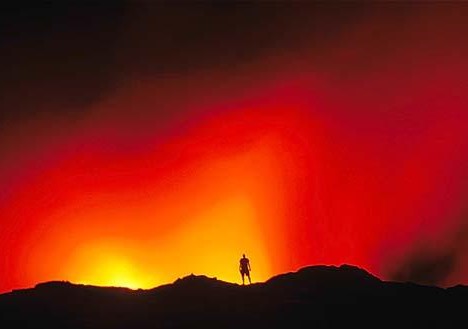 When volcanoes appear on the news it is generally not good news, see the recent case of the Icelandic volcano with the unpronounceable name (even writing it is no joke: Eyjafjallajökull) with all the inconveniences it has caused, but on the other hand it is nature, and volcanoes only know how to do one thing: erupt! Around the world at any given moment dozens of volcanoes "smoke", causing havoc among the local populations that live on the slopes. We have drawn up for you the top ten of the most threatening mountains of fire on the planet. And we have discovered that…
When volcanoes appear on the news it is generally not good news, see the recent case of the Icelandic volcano with the unpronounceable name (even writing it is no joke: Eyjafjallajökull) with all the inconveniences it has caused, but on the other hand it is nature, and volcanoes only know how to do one thing: erupt! Around the world at any given moment dozens of volcanoes "smoke", causing havoc among the local populations that live on the slopes. We have drawn up for you the top ten of the most threatening mountains of fire on the planet. And we have discovered that… 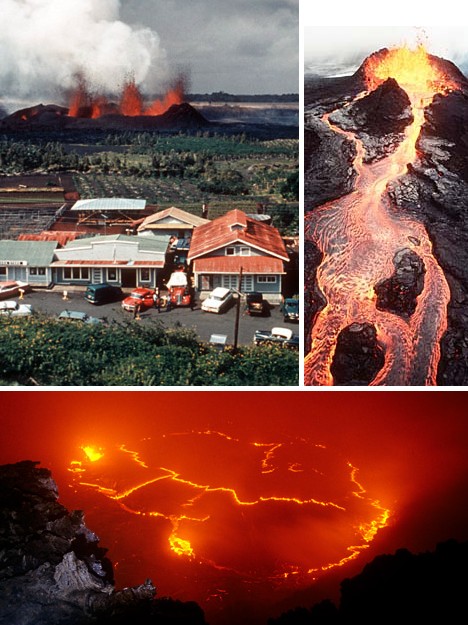 .. is located in Hawaii (Big Island) the volcano considered to be the most active on Earth. To give you an idea, know that during its most recent eruption that began in January 1983, Kilauea expelled enough lava to pave a road around the planet three times! It is 1247 meters high, a trifle compared to the gigantic "neighbor" Mauna Loa (4169 m!), but the spectacle of its lava fountains and rivers of molten rock that slowly flow is truly unique.
.. is located in Hawaii (Big Island) the volcano considered to be the most active on Earth. To give you an idea, know that during its most recent eruption that began in January 1983, Kilauea expelled enough lava to pave a road around the planet three times! It is 1247 meters high, a trifle compared to the gigantic "neighbor" Mauna Loa (4169 m!), but the spectacle of its lava fountains and rivers of molten rock that slowly flow is truly unique. 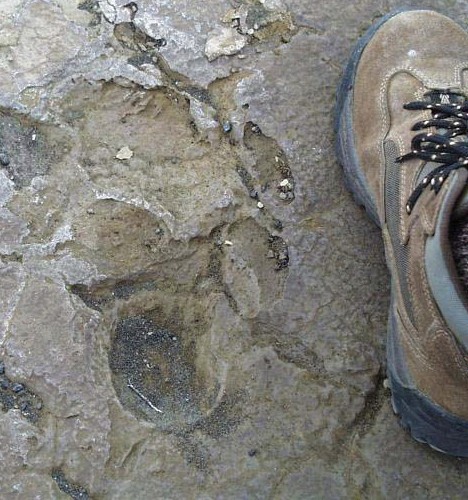 The fact that Kilauea means "to spit" in Hawaiian proves that the volcano was erupting long before the famous Captain Cook discovered the Hawaiian Islands in the late eighteenth century. From that time, perfectly preserved footprints in the hardened lava are attributed to about eighty warriors belonging to a dissident Hawaiian faction that died in a pyroclastic flow from Kilauea.
The fact that Kilauea means "to spit" in Hawaiian proves that the volcano was erupting long before the famous Captain Cook discovered the Hawaiian Islands in the late eighteenth century. From that time, perfectly preserved footprints in the hardened lava are attributed to about eighty warriors belonging to a dissident Hawaiian faction that died in a pyroclastic flow from Kilauea. 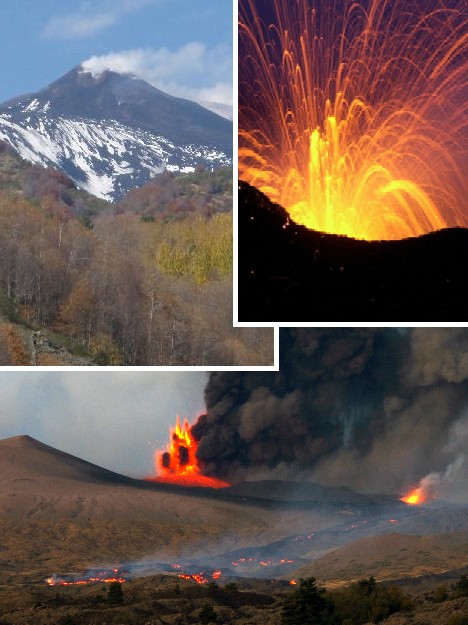 Of course we could not fail to consider Etna, one of the symbols of our beautiful Sicilian region, as famous as the "nearby" Vesuvius (but much higher). Etna boasts a more or less constant eruption in the last 2,000 years even if its "history" dates back to about 300,000 years ago (most of Etna's most spectacular eruptions occurred in prehistory).
Of course we could not fail to consider Etna, one of the symbols of our beautiful Sicilian region, as famous as the "nearby" Vesuvius (but much higher). Etna boasts a more or less constant eruption in the last 2,000 years even if its "history" dates back to about 300,000 years ago (most of Etna's most spectacular eruptions occurred in prehistory). 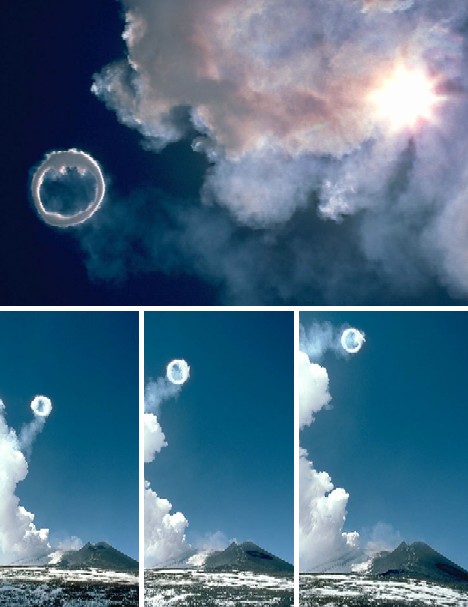 The phenomenon of smoke rings is rare and curious, and on some occasions Etna has created several of them, which last about 15 minutes and can reach a diameter of 600 meters! Some of these rings are documented with photographs taken during the eruption of Etna in 2000.
The phenomenon of smoke rings is rare and curious, and on some occasions Etna has created several of them, which last about 15 minutes and can reach a diameter of 600 meters! Some of these rings are documented with photographs taken during the eruption of Etna in 2000. 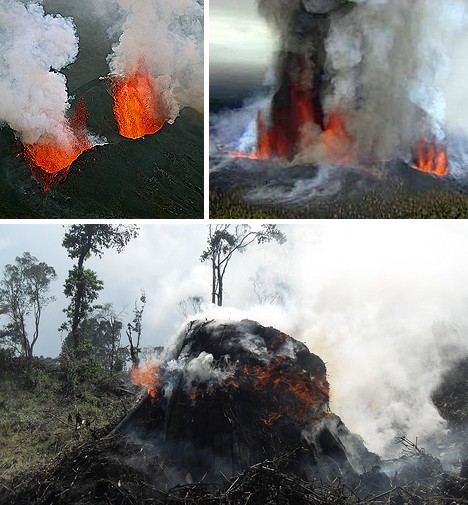 Mount Nyamuragira is an active volcano located in the Virunga Mountains of the Democratic Republic of the Congo. Although it has erupted more than 30 times since European explorers began documenting the mountain's activity (1880), this has not stopped the area (also famous as one of the last bastions for the protection of numerous species of monkeys) from being densely populated.
Mount Nyamuragira is an active volcano located in the Virunga Mountains of the Democratic Republic of the Congo. Although it has erupted more than 30 times since European explorers began documenting the mountain's activity (1880), this has not stopped the area (also famous as one of the last bastions for the protection of numerous species of monkeys) from being densely populated. 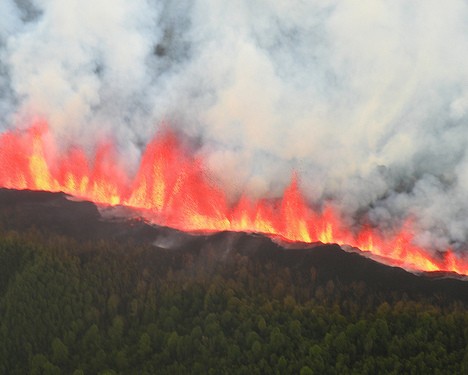
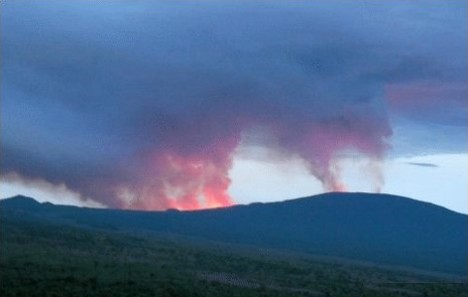 Mount Nyamuragira celebrated the arrival of the New Year with an eruption: on January 2, 2010, lava began to flow from the main crater, descending 500 meters so quickly that evacuation operations for the local inhabitants were very difficult and disorganized.
Mount Nyamuragira celebrated the arrival of the New Year with an eruption: on January 2, 2010, lava began to flow from the main crater, descending 500 meters so quickly that evacuation operations for the local inhabitants were very difficult and disorganized. 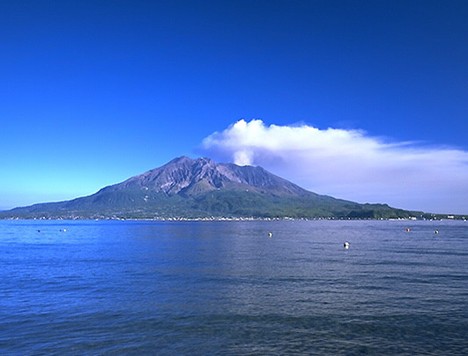
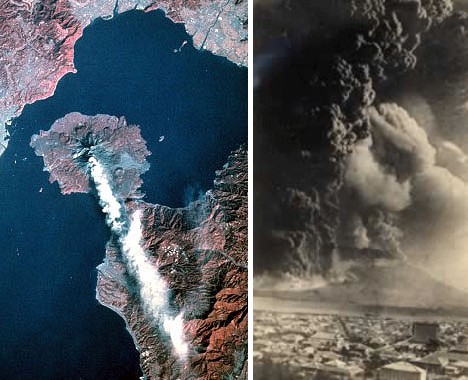 Sakurajima volcano is located on what was once an island in southern Japan, Kagoshima Bay. The island is now connected to the mainland by a flat peninsula created by lava flows during the mountain's incredible eruption in 1914. Sakurajima is 1,117 m above sea level and has been erupting more or less constantly since 1955.
Sakurajima volcano is located on what was once an island in southern Japan, Kagoshima Bay. The island is now connected to the mainland by a flat peninsula created by lava flows during the mountain's incredible eruption in 1914. Sakurajima is 1,117 m above sea level and has been erupting more or less constantly since 1955. 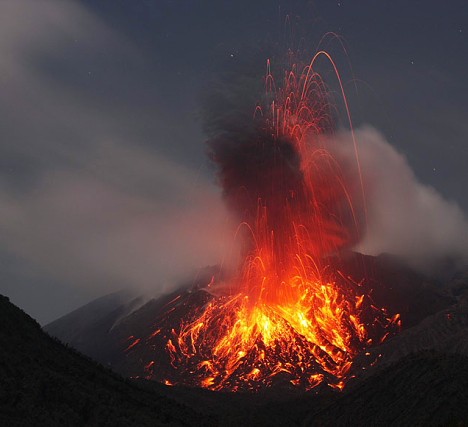 This is a very dangerous area, which has already brought death and destruction in the past.
This is a very dangerous area, which has already brought death and destruction in the past. 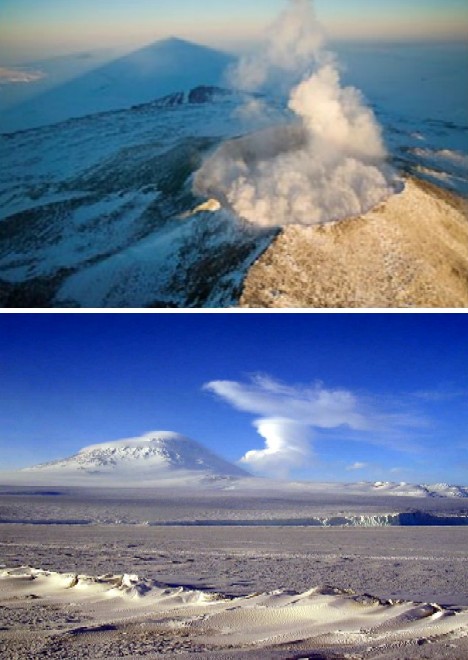 The world's most "southern" active volcano is Mount Erebus, which has been active since 1972, although eruptions vary greatly in intensity. The 3,794 m volcano is covered in snow, but the crater is a beautiful shade of hot red, where there is a lake of fire that can only be seen well from space.
The world's most "southern" active volcano is Mount Erebus, which has been active since 1972, although eruptions vary greatly in intensity. The 3,794 m volcano is covered in snow, but the crater is a beautiful shade of hot red, where there is a lake of fire that can only be seen well from space. 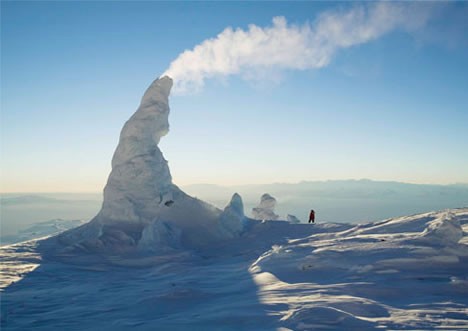 Although considered to be in a state of eruption, Mount Erebus is behaving rather "quietly" and is extensively studied by volcanologists at the nearby McMurdo Station (USA) and Scott Base (NZ).
Although considered to be in a state of eruption, Mount Erebus is behaving rather "quietly" and is extensively studied by volcanologists at the nearby McMurdo Station (USA) and Scott Base (NZ). 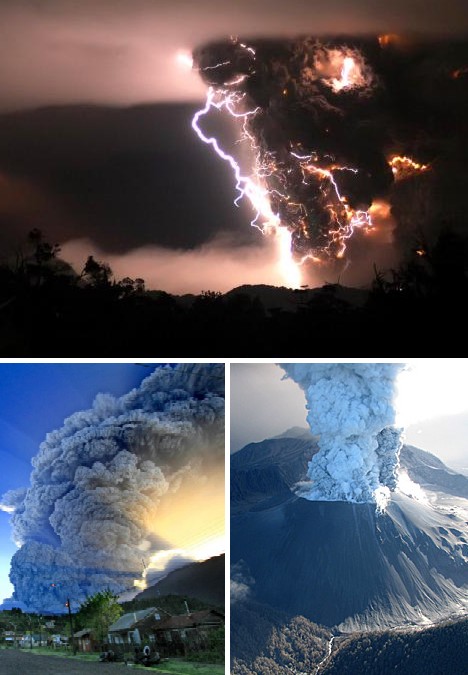 The May 2, 2008 eruption of the Chaitén volcano in southern Chile was an event that took scientists by surprise, given that the previous eruption was estimated to have occurred around 9,500 years ago. The initial phases were characterized by the ejection of voluminous ash clouds crossed by terrifying incandescent lightning.
The May 2, 2008 eruption of the Chaitén volcano in southern Chile was an event that took scientists by surprise, given that the previous eruption was estimated to have occurred around 9,500 years ago. The initial phases were characterized by the ejection of voluminous ash clouds crossed by terrifying incandescent lightning. 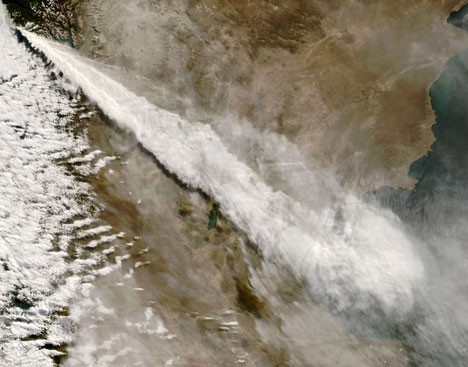 Within 24 hours of the eruption, a huge ash cloud had risen tens of thousands of meters into the sky. The cloud was photographed by orbiting satellites (pictured above), which showed it extending across the width of Argentina toward the South Atlantic.
Within 24 hours of the eruption, a huge ash cloud had risen tens of thousands of meters into the sky. The cloud was photographed by orbiting satellites (pictured above), which showed it extending across the width of Argentina toward the South Atlantic. 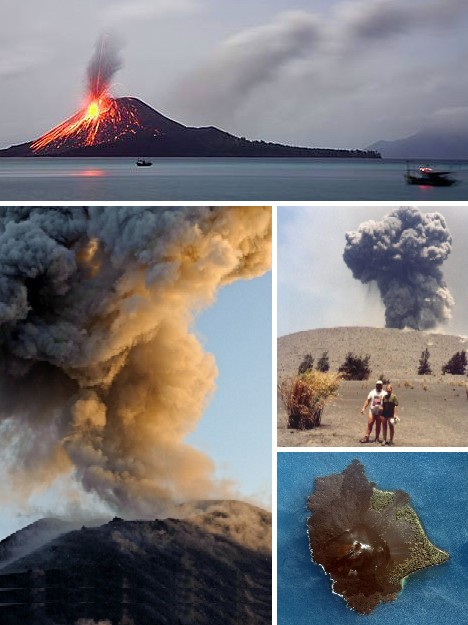 Who among you remembers the disaster movie "Krakatoa East of Java"? It was a blockbuster from the 60s that narrated the dramatic eruption of the Indonesian volcano Krakatua in 1883: but the 36,000 deaths of that time could be nothing compared to those that could be caused today by the volcano that arose on the Krakatua caldera, "Anak Krakatua" (son of Krakatua), today really too densely populated.
Who among you remembers the disaster movie "Krakatoa East of Java"? It was a blockbuster from the 60s that narrated the dramatic eruption of the Indonesian volcano Krakatua in 1883: but the 36,000 deaths of that time could be nothing compared to those that could be caused today by the volcano that arose on the Krakatua caldera, "Anak Krakatua" (son of Krakatua), today really too densely populated. 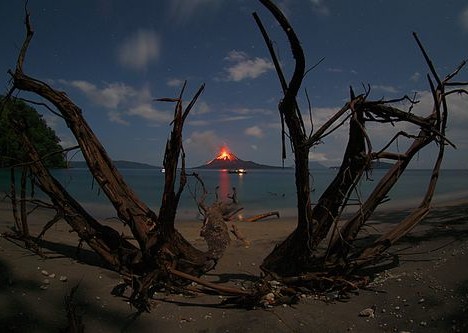
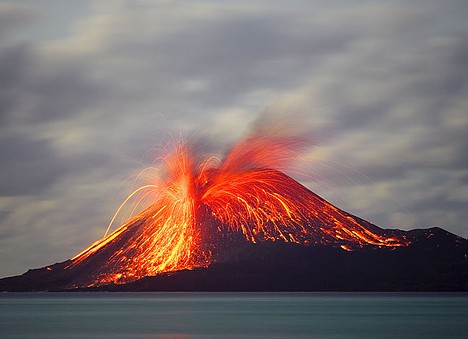 The current eruptive phase of the volcano began in April 2008 and is dangerously ongoing.
The current eruptive phase of the volcano began in April 2008 and is dangerously ongoing. 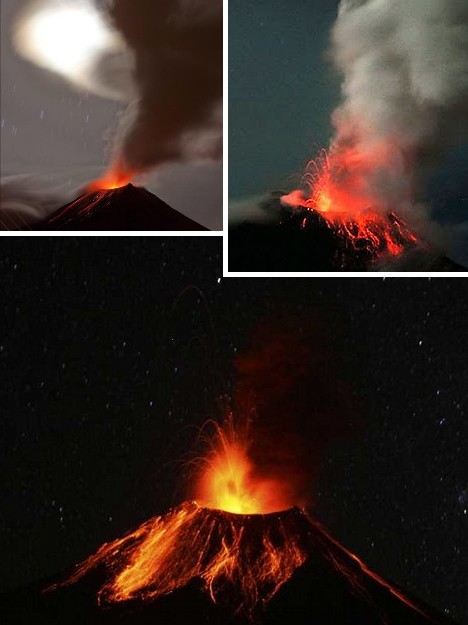 Tungurahua is one of the world's tallest volcanoes, rising 5,023 m above sea level in the Andes mountains of the South American nation of Ecuador. These figures will likely need to be revised as Tungurahua "woke up" in 1999, with major eruptions occurring in 2006 and 2008.
Tungurahua is one of the world's tallest volcanoes, rising 5,023 m above sea level in the Andes mountains of the South American nation of Ecuador. These figures will likely need to be revised as Tungurahua "woke up" in 1999, with major eruptions occurring in 2006 and 2008. 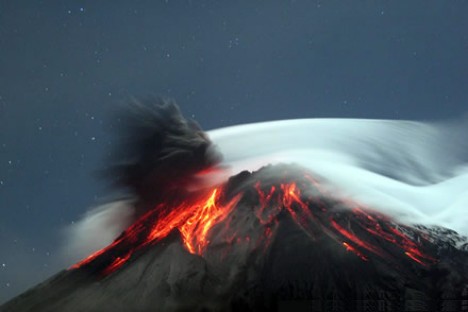 Until then, like most volcanoes in the Andes, the slopes of Tungurahua were covered in snow and had a small glacier on the summit.
Until then, like most volcanoes in the Andes, the slopes of Tungurahua were covered in snow and had a small glacier on the summit. 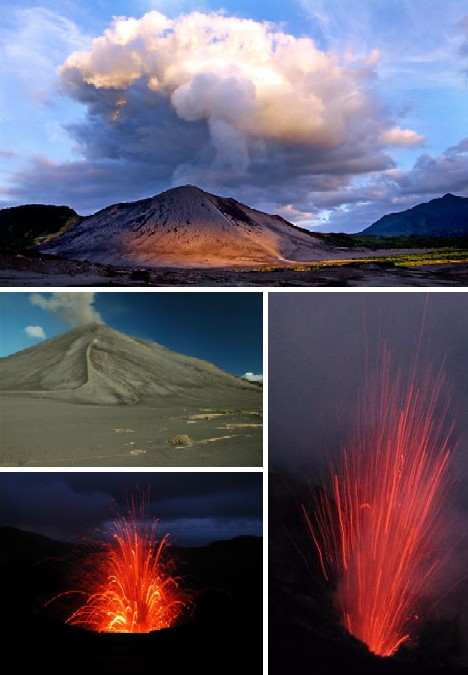 Mount Yasur on Tanna Island is located in the Vanuatu archipelago, in the South Pacific. It is famous not only because it has been erupting for many centuries, but because it still does so today and several times an hour! Short, with its 361m of height, but crowned on its summit by an almost perfectly circular crater, a whopping 400 meters wide!
Mount Yasur on Tanna Island is located in the Vanuatu archipelago, in the South Pacific. It is famous not only because it has been erupting for many centuries, but because it still does so today and several times an hour! Short, with its 361m of height, but crowned on its summit by an almost perfectly circular crater, a whopping 400 meters wide! 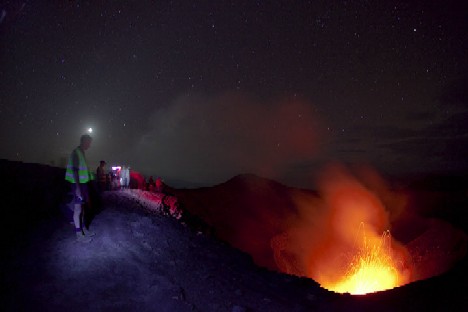 Like Hawaii's Kilauea, Mount Yasur erupts in a very predictable manner and has a constant level of activity, allowing tourists to get very close without risk. An example of this was seen on the broadcast of "Survivor: Vanuatu – Islands of Fire", where the winning contestants of a reward challenge were treated to a picnic of hot dogs and beer, while Mount Yasur provided a unique fireworks display before their eyes.
Like Hawaii's Kilauea, Mount Yasur erupts in a very predictable manner and has a constant level of activity, allowing tourists to get very close without risk. An example of this was seen on the broadcast of "Survivor: Vanuatu – Islands of Fire", where the winning contestants of a reward challenge were treated to a picnic of hot dogs and beer, while Mount Yasur provided a unique fireworks display before their eyes. 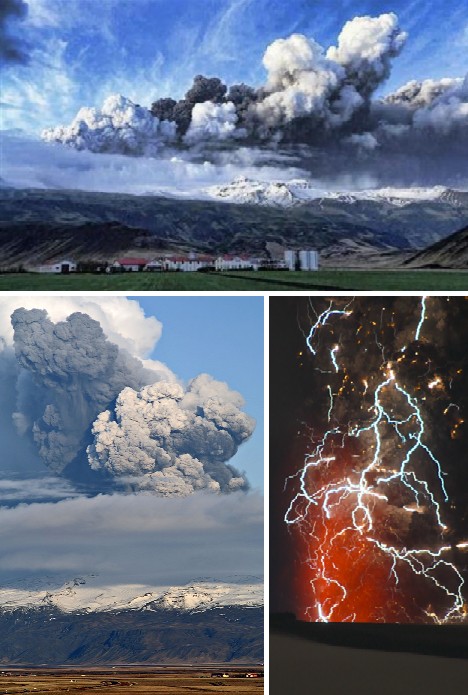 It's a case of "last but not least": here we close this special top ten with the volcano with the tongue-twister Icelandic name… Eyjafjallajökull! Let's all surrender to the fact that the current eruptive phase of the volcano may have just begun: the previous case of eruption began in December 1821 and lasted for three years. Volcanologists have established that Eyjafjallajökull had previously "made itself felt" in 1612, and even before that in 920 AD.
It's a case of "last but not least": here we close this special top ten with the volcano with the tongue-twister Icelandic name… Eyjafjallajökull! Let's all surrender to the fact that the current eruptive phase of the volcano may have just begun: the previous case of eruption began in December 1821 and lasted for three years. Volcanologists have established that Eyjafjallajökull had previously "made itself felt" in 1612, and even before that in 920 AD. 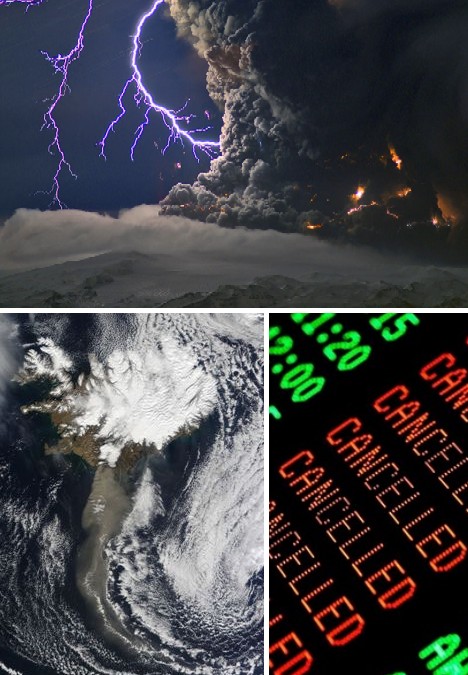 All three previous eruptions of Eyjafjallajökull have been followed by the eruption of Katla, a much larger subglacial volcano just 25 kilometres away. In a BBC interview on 20 April, Icelandic President Ólafur Grímsson described the recent chaos caused by Eyjafjallajökull as "a little dress rehearsal", and warned that "the time for Katla to erupt is getting closer", advising European governments and even airline regulators around the world to start factoring in the possibility of Katla erupting. Poor us!
All three previous eruptions of Eyjafjallajökull have been followed by the eruption of Katla, a much larger subglacial volcano just 25 kilometres away. In a BBC interview on 20 April, Icelandic President Ólafur Grímsson described the recent chaos caused by Eyjafjallajökull as "a little dress rehearsal", and warned that "the time for Katla to erupt is getting closer", advising European governments and even airline regulators around the world to start factoring in the possibility of Katla erupting. Poor us! 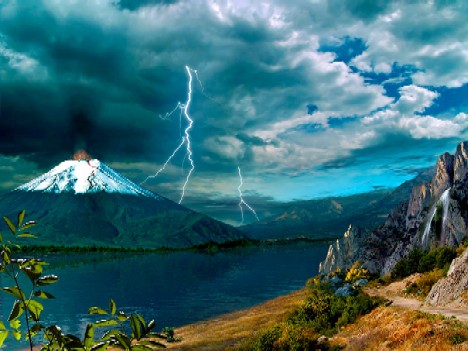
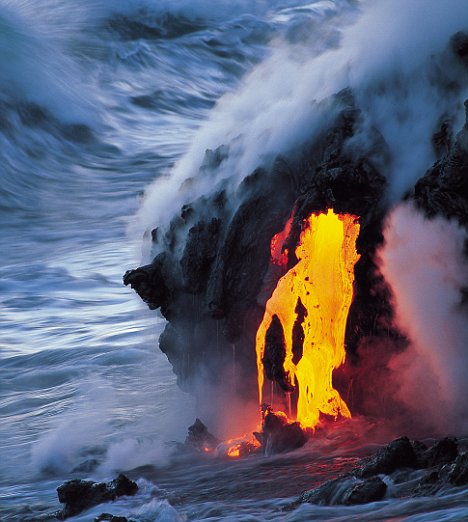 This time too we took a nice trip around the world, but if you were looking for "hot" places for a nice relaxing holiday, we can recommend others, fiery yes, but definitely quieter!
This time too we took a nice trip around the world, but if you were looking for "hot" places for a nice relaxing holiday, we can recommend others, fiery yes, but definitely quieter!
Related Blogs
Potrebbe interessarti
Where to sleep in Rome: a short guide to finding a hotel
When you are about to leave for a trip, half of the organization time is lost in choosing the accommodation. In a city as big and chaotic as the capital of the Bel Paese, it is inevitable to ask yourself: where to sleep in Rome ? Between apartments, hotels and B&Bs there is something for […]
Around the world in 40 shots
In a society that bombards us with images every day, it is worthwhile to pause every now and then to look at the quality of some of these. This is why for once we want to pay homage to the skill of the lens wizards, established photographers, emerging ones, or even passionate beginners, by highlighting […]
Under the volcano
When volcanoes appear on the news it is generally not good news, see the recent case of the Icelandic volcano with the unpronounceable name (even writing it is no joke: Eyjafjallajökull) with all the inconveniences it has caused, but on the other hand it is nature, and volcanoes only know how to do one thing: […]
